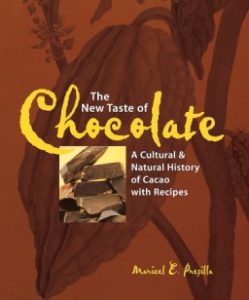The New Taste of Chocolate Revised: A Cultural and Natural History of Cacao with Recipes. / by Maricel E. Presilla. Published by Ten Speed Press, 2009.

Maricel Presilla, an accomplished chef and restaurateur, shares the techniques for spicing chocolate and bringing tropical flavors from South American dishes to our home kitchens. Her natural history of chocolate, complete in itself, has sketched out not only the mysterious beginnings of the cacao tree and the processes taken to prepare the beans for the chocolate-making industry, but also the extravagance of flavor and texture of the regal chocolate bean.
It’s delightful that chocolate begets so many forms of chocolate: drinks, sauces, confections and cakes, enriched by the addition of nuts, coffee, spices and even chiles. Presilla’s recipes are the delicious finale to her treatise on chocolate, a natural history of the food of the gods! In this last section of her book, The New Taste of Chocolate: A Cultural and Natural History of Cacao with Recipes, by Maricel E. Presilla, the variety of hot chocolate drinks gives a sense of the versatility and cultural influences of Mexico, Guatemala, Cuba, Venezula, Argentina, and Equador. With chocolate dulce de leche, horchata, mole, cacao-chile balls, sal de cacao y chile, for starters, even an inexperienced cook easily follows the instructions for delectably exotic treats using chocolate that’s not just for candies.
But, keeping to the sweet side of chocolate, who wouldn’t like to try “Tropical Night Brownies”, or “Morir Soñando Truffles”, a name that the author translates is “to die dreaming truffles”? Truffles are the ultimate chocolates, aren’t they? Her recipe introduces the idea that chocolate (67% or so), citrus, sugar, cream and rum mingle to thicken and plump up into lovely ganache fit to form into truffle balls, coated with orange zest and cacao nibs. The brownies have two kinds of chocolate, yielding 70% and 59% cacao in 5 total ounces, loaf sugar, Venezuelan rum, unsweetened coconut, roasted cashews, and cacao nibs. The brownies are deliciously chunky-rich in texture.
My favorite part of the book begins with the recipes, and partly because they progress, from a primal venture into the beans as garnish, to chocolate salt, to chocolate-garlic spread, and then the confections and cakes you would expect, before turning to chocolate sauce (mole), truffles and a main dish.
An exchange of knowledge takes place about exactly how cacao beans from certain estates and plantations should taste as we follow her leisurely detail through the countries and localities known for the best cacao beans, and thus the best chocolate in our markets. A tropical tree and its fruit, cacao is preciously handled locally (within 20 degrees north or south of the Equator) from harvesting to fermenting and drying. Since the gene pool of the most flavorful beans is narrowing due to over production and market demand, plans to judiciously hybridize the best trees aim at a stronger tree, one that resists pests and fungus, while retaining flavor. A cacao tree matures at between 2 and four years; its useful life may last twenty or more years, with several harvestings each year from a single tree.
Chocolate as we know it, in wrappers that proclaim origin and percentages of cacao, has traveled a long way from cacao pod harvest, pulp and bean fermentation and then bean drying processes to the edible bar nestled in your palm. As of the book’s publishing date, scientists together with growers are working towards supporting the fragile industry that relies on a mixture of old plantation style methods of preparing the beans and the 21st century manufacturing which strives to create the most desired chocolate. There’s great respect for the cacao bean that is so particular about its growing conditions. And fascinatingly, it’s possible to enjoy a measure of old-world style chocolate drinks, new world style chocolate recipes, and deserts from American chefs who love its rich versatility.
See Maricel Presilla’s website for restaurants and source for Latin American food Zafar and Cucharamama here.
Follow


